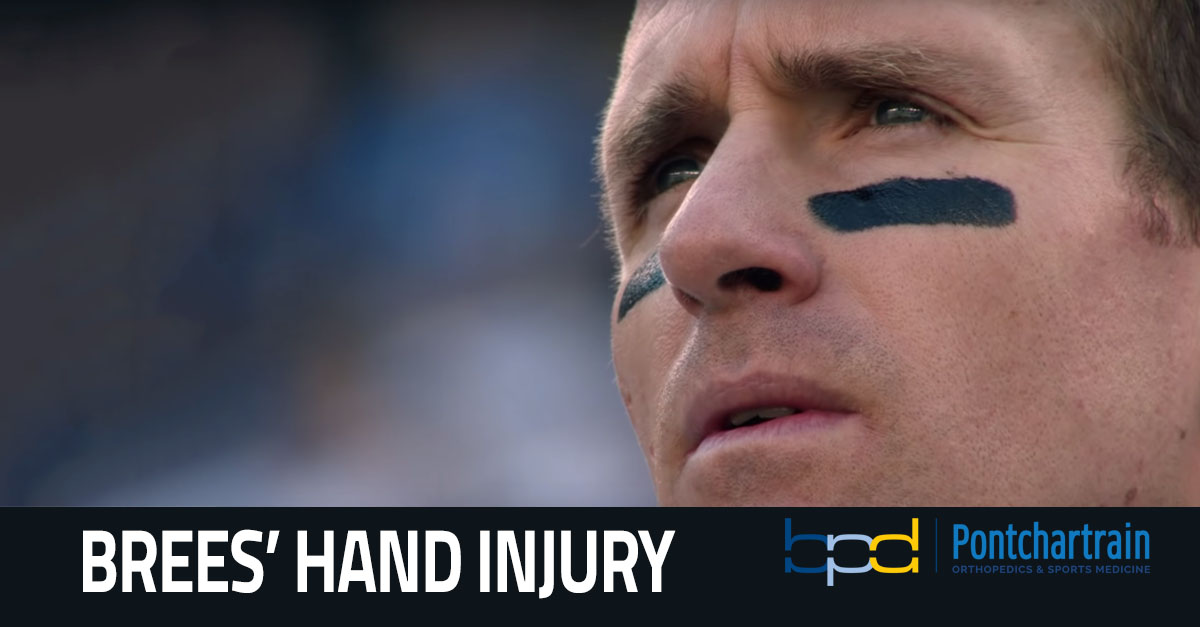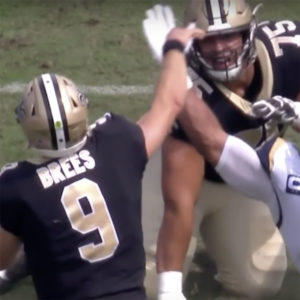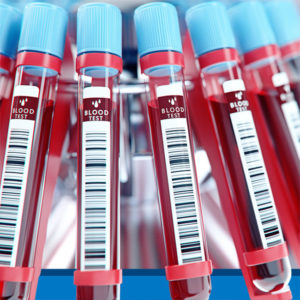
What Caused Drew Brees’ Hand Injury?
New Orleans Saints quarterback Drew Brees is expected to miss significant playing time after suffering ligament damage to the thumb on his throwing hand. Determining the exact nature of his injury will go a long way toward understanding how long he’ll be sidelined. In today’s blog post, we will discuss Drew Brees’ hand injury, his surgical options, and the factors that can affect his long-term prognosis.
 If you saw the replay (and by now, who hasn’t?), the impact to Drew’s hand doesn’t look earth shattering. But unfortunately, a karate chop from an NFL defensive lineman delivers a lot of force. And, when enough force is applied where the thumb meets the hand (known as the metacarpophalangeal joint), bad things happen.
If you saw the replay (and by now, who hasn’t?), the impact to Drew’s hand doesn’t look earth shattering. But unfortunately, a karate chop from an NFL defensive lineman delivers a lot of force. And, when enough force is applied where the thumb meets the hand (known as the metacarpophalangeal joint), bad things happen.
Drew Brees’ hand injury is also known as skier’s thumb. A fall on an outstretched hand with a ski pole in the palm of your hand creates the force necessary to stress the thumb and stretch or tear the ligament.
To put the forces involved into perspective, this injury can also happen in an automobile crash when the driver has the thumb draped over the steering wheel. In Drew’s case, the force came from Los Angeles Rams defender Aaron Donald’s hand.
So How Bad Is it?
“The big question,” according to Dr. Brandon P. Donnelly of Pontchartrain Orthopedics and Sports Medicine, “is whether we are dealing with a partial tear of the thumb MCP collateral ligament, or a complete rupture. Most often, we are able to distinguish between a complete and partial tear using a physical exam. We assess for the stability of the joint. With a complete tear, the thumb can be moved beyond the point where the ligament would normally stop it. With a partial injury, there is often a stable, but painful exam with a noted endpoint when testing the ligament.”
Fellow NFL quarterback Jay Cutler suffered a similar injury in 2016. Because he did not suffer a complete tear, however, Cutler only missed four games.
The Saints’ former Super Bowl MVP was initially thought to be favoring immediate surgery, with a predicted recovery time of around six weeks. Brees later said he would seek a second opinion. That’s a testament to the importance of the ulnar collateral ligament of the metacarpophalangeal joint. These ligaments help quarterbacks grip the ball securely, then throw with velocity and control.
“The biggest determining factor for surgery is the stability of the thumb,” Dr. Donnelly says. “If the ligament is partially injured and stable, it can be successfully treated with non-surgical options. However, a complete ligament tear is inherently unstable, and will do best with surgical repair.”
“The big question is whether we are dealing with a partial tear of the thumb MCP collateral ligament, or a complete rupture. “Brandon P. Donnelly, MD
Why Collateral Ligaments are Critical for Quarterbacks

“The collateral ligaments give us side-to-side support of the thumb, enabling us to grip and hold,” Dr. Donnelly says. “Without the ulnar collateral, we would not have any support to grasp to open a jar. We also couldn’t side pinch with the thumb, such as gripping your key to start your car. In order to grip and throw a football, you must use the ulnar aspect of the thumb. As was evident on the sidelines, without a stable ligament, Drew couldn’t even hold the football, much less throw it.”
Symptoms are characterized by pain at the base of the thumb, in the webbing that leads to the index finger. Swelling then leads to weakness, or even an inability to grasp things with that hand. Blue or black discoloration of the skin may occur. Pain worsens with movement in any or all directions, and that pain can radiate to the wrist.
“With both partial and complete injuries, the ligament requires about six weeks to heal. “Brandon P. Donnelly, MD
Drew’s Surgical Options
If the ligament is torn off the bone, surgical treatment would likely include operative exploration and ligament repair using a suture anchor. “The torn area is exposed, then cleaned of any remnant tissue,” Dr. Donnelly says. “The bone is usually scuffed up to create a more ideal surface for ligament healing. Then an anchor which is akin to a dry-wall molly bolt with sutures attached is used to repair the ligament back to bone.”
With both partial and complete injuries, the ligament requires about six weeks to heal. But that doesn’t mean Brees would be immediately cleared to play. “In partial injuries, there is some ligament still intact stabilizing the joint – which is not the case in complete tears,” Dr. Donnelly says. “Return after partial injury is variable depending on how severe the partial injury is. However, the ligament is not at its full strength until three to four months out from injury.”
Although unlikely to be Brees’ injury, as we have not heard it mentioned, another possible variant of this skier’s thumb injury is to have a fracture of the thumb bone.
Another possible variant of this skier’s thumb injury is to have a fracture of the thumb bone – although this is unlikely to be Brees’ injury, since we have not heard it mentioned. We call this a ligament avulsion fracture and is quite common occurring at the base of the proximal phalanx, where the thumb meets the hand: “Sometimes, the ligament is stronger than the bone itself. And when enough pressure is applied, the bone can fracture. The ligament essentially tears a little piece of bone off with it.”
A ligament avulsion fracture would change both the treatment plan, and potential recovery time. “If there is a fracture instead of a ligament tear, depending on how big the fracture bone is, the repair is different,” Dr. Donnelly confirms. “Avulsion fractures are often fixed with screws, while pure ligament tears are fixed using anchors to reattach the ligament back down to the bone. Sometimes, pins are used to reinforce a repair method, but are usually temporary for a few weeks or so.” The advantage of an avulsion fracture versus a complete tear is bone to bone healing occurs more quickly than ligament to bone. Evaluation of healing is easier as well using standard radiography and CT imaging.
The Latest Techniques for the Fastest Recovery
 To accelerate healing, doctors can treat the injury with platelet-rich plasma. In this process, the patient’s own blood is spun through a centrifuge to isolate “growth factors,” which are then injected back into the body. Pontchartrain Orthopedics and Sports Medicine offers this and other regenerative therapies.
To accelerate healing, doctors can treat the injury with platelet-rich plasma. In this process, the patient’s own blood is spun through a centrifuge to isolate “growth factors,” which are then injected back into the body. Pontchartrain Orthopedics and Sports Medicine offers this and other regenerative therapies.
“With newer techniques that enable us to stabilize the joint while the ligament injury heals, we can rehab quicker and get back to activities quicker – and thus a return of six weeks compared to three months,” Dr. Donnelly says. “New techniques include Thumb UCL Repair With InternalBrace™ Ligament Augmentation. The surgeon may also use the WALANT method, a relatively new technique of performing certain surgeries without the need of general anesthetics.”
If there is a fracture component, as a pro athlete, he might also utilize a bone-growth stimulator. This is something typically only employed in cases of delayed or poorly healing bone, but could help limit down time.
Brees’ hand will likely be in a non-removable dressing for a week or so, then either a cast or – more often – a removable brace, so that he can begin range-of-motion therapy.
“The biggest risk of returning too soon is re-injuring the repaired ligament. “Brandon P. Donnelly, MD
How Will Drew Know When He’s Ready to Return?
Whether a partial tear or a total rupture with a bone fracture, Brees will have to caution against going back to football before the repairs have properly healed.
“The biggest risk of returning too soon is re-injuring the repaired ligament,” Dr. Donnelly cautions. “If that happens, likely a reconstruction would need to be performed where a free tendon from elsewhere in the body is used to make a new ulnar collateral ligament. This is similar to how ACL injuries are currently treated.” So, for Drew Brees and his many fans, patience will be key. He’ll know when he’s ready – but it may take a while. “Different imaging modalities can be used to assess the repaired ligament, such as ultrasound or MRI.” Dr. Donnelly adds. “Most often, it is a clinical determination based off pain, strength and range of motion.”
Never Count Drew Brees Out
Make no mistake, Drew Brees’ hand injury is serious. However, he’s been counted out before – then came roaring back to win a Super Bowl. Rest assured, Drew will have the best team of specialists evaluating his injury, performing the repair, and guiding him back to the field. Besides, when it’s late in the game and things are looking dark, you’ve got a fighting chance if Drew Brees is in the huddle.
This site is not intended to and does not provide medical advice, professional diagnosis, opinion, treatment or services to you or to any other individual. Through this website and links to other websites, Brandon P. Donnelly, MD provides general information for educational purposes only. The content provided in this website and links, is not a substitute for medical care or treatment. You should not use this information in place of a consultation or the advice of your healthcare provider. Brandon P. Donnelly, MD is not liable or responsible for any advice, course of treatment, diagnosis or any other information, services or product you obtain through this site.

